Watering potatoes: watering methods and rules
Many believe that potato - a culture that is not demanding for care, which consists only in hilling and weeding. Nevertheless, adherence to simple rules of agricultural technology for growing potatoes can increase yields significantly.
Content:
Potatoes: the best varieties to grow
Currently, there are about three and a half thousand varieties potatoes... Depending on the ripening time, potato varieties can be divided into:
- Early - up to 60 days
- Medium early - up to 80 days
- Mid-season - up to 95 days
- Medium late - up to 100 days
- Late - up to 120 days.
The variety of potatoes should be chosen depending on the climatic conditions of your region and the quality characteristics of the soil. It is important to note that early potato varieties are characterized by low starch content and low yields, while later varieties have excellent taste and excellent yield, but are more susceptible to different diseases.
The most popular potato varieties:
- Potatoes Nevsky are characterized by good yield, medium early ripening and the ability to grow on any type of soil. Up to 15 root crops weighing about 130 grams are harvested from one bush. Oval tubers with creamy flesh and yellow skin.
- Venetta (early, drought tolerant), Symphony (mid-season) and Temp (late) are yellow potato varieties. They are characterized by a yellow flesh of tubers and a starch content of 13 (Venetta) to 22 (Temp) percent. Yellow potatoes are considered the most favorite in Russian cuisine, due to the high starch content, the tubers boil well and have a pleasant sweet taste.
- Red potato varieties (Borodyansky pink, Sample red) are considered the most useful, they contain little fiber and are used in dietary nutrition. The tubers are reddish in color with a creamy flesh and a starch content of 14 to 19 percent.
- Rosalind is recognized as the best early ripening potato. Tubers with red skin and yellow flesh, starch content - 17%.
- Romano is a Dutch high-yielding variety with an early maturity. The pulp of the tubers is light cream in color with a starch content of 19%. The potatoes are delicious. The yield of the variety does not depend on weather conditions.
Watering potatoes: types and rules
Watering Is an important part of potato care. Excess moisture before it appears negatively affects root system plants: it is located too close to the surface of the earth, which further makes it difficult to obtain moisture and nutrients from the soil. During the growing season, excess moisture contributes to the susceptibility of the plant diseases and rotting tubers.
In turn, the lack of moisture retards the development of the plant, reduces the yield and quality of tubers.
Watering can be done by the following methods:
- Sprinkling - watering carried out through a hose, the water curtain should be fine-droplet to prevent erosion of the soil at the root system. Sprinkling, on the contrary, reduces water consumption and contributes to an even distribution of moisture, although this factor depends on the strength of the wind.The disadvantage of this method is its high labor intensity and the creation of favorable conditions for the development of diseases.
- Surface irrigation in furrows is preferable to sprinkling, it has a better effect on potato... The surface irrigation method is used on lands with a groundwater level not higher than 4 m. The disadvantage of this method is the uneconomical water consumption.
- Drip irrigation - water is supplied locally in trickles or drops through irrigation pipes or hoses directly to the site of the root system, the rest of the soil surface remains dry, which significantly reduces water consumption and the number of soil loosening procedures.
Drip irrigation is currently the most advanced method for watering potatoes. Despite the high cost, it has many advantages:
- Increase in productivity by 3 times.
- Improving the quality of tubers.
- Substantial water savings.
- Significant reduction in labor costs.
- The ability to combine watering with top dressing.
Potatoes, like any plant, have their own care features, which include irrigation technology:
- Before sprouting, potatoes do not need additional moisture: the moisture contained in the soil is quite enough.
- Potatoes, although they can withstand short-term droughts, require regular watering... A 6 centimeters dry layer of soil or withering lower leaves will serve as a sign of the need for moisture.
- The greatest need for watering in potatoes occurs during the period of bud appearance, which coincides with the beginning of the formation of tubers, and flowering.
- During periods of drought, a small amount of rain and in August, special attention should be paid to moistening the soil, which will extend the growing season and, accordingly, will increase yields.
- After each watering, the soil must be loosened, since the moistened soil becomes compacted and further complicates the access of moisture and air to the roots.
- On light soils, potatoes are watered in small portions and more often than on heavy ones.
- On heavy soils, watered abundantly, in portions, waiting for the water to be absorbed into the ground.
To get a good harvest when watering, it is recommended to follow a number of rules:
- The first watering is carried out at the rate of 2 liters of water per bush.
- Subsequent watering - 3-4 liters of water per bush.
- It is recommended to take warm water (pre-heated in barrels).
- The best time for watering is morning or evening, during the day the moisture evaporates too quickly, without having time to penetrate the soil.
- Do not direct the stream of water directly at the bush, use rain or drip irrigation.
- Do not water 2 weeks before harvest.
- When watering manually, moisten the soil in portions: pour in a liter of water - wait until it is absorbed, then the next portion, etc.
Compliance with the technology of watering potatoes contributes to the correct formation and development of the root system, prevents the germination of young root crops and has a beneficial effect on the size of tubers. Lack or excess of moisture during the period of potato growth can cause a loss of up to 60% of the yield and a deterioration in the quality of tubers by 20%.
Potato care
Caring for potatoes, in addition to watering, includes:
- Loosening
- Hilling
- Destruction weeds
- Top dressing
- Fight against late blight
5-6 days after landing you need to loosen the ground for the first time, simultaneously destroying weeds... Loosening prevents the formation of a hard crust on the surface of the soil, its waterlogging and promotes the penetration of air to the tubers. Loosening should be carried out every time the soil surface hardens, taking care not to damage the stems. If there is a risk of waterlogging the soil, drainage should be done.
Hilling is carried out in two stages:
- The first is when the plant reaches a height of 12-15 cm.
- The second is 12 days after the first.
Before and after hilling, the soil must be watered. It is best to sprinkle potatoes in the morning or in the evening; from 12 to 18 hours, this procedure is not recommended. In cold areas with a threat of frost potato you need to huddle immediately after germination of seedlings, covering them from the cold with earth from the aisles. Hilling stimulates the growth of the root system, which, by consuming more moisture and nutrients, promotes better growth and maturation of tubers.
The last hilling is carried out no later than the beginning flowering: with late processing there is a risk of damage to the tubers or root system.
In hot, dry weather, in the absence of the possibility of watering the potatoes, hilling is not recommended, since the tubers can simply "bake" in the soil. In this case, it is better to replace hilling by loosening.
More information on watering potatoes can be found in the video.
The main feeding do three times:
- The first is 30 days after planting.
- The second is during the budding period.
- The third is at the end of flowering.
For feeding, you can take at the rate of 1 square meter:
- Urea - 10 grams.
- Potassium sulfate - 10 grams.
- Superphosphate - 20 grams.
- Or
- Chicken droppings - 200 g.
Fertilizers can be dissolved in water for irrigation or scattered in furrows (when irrigating along furrows at a distance of 12 cm from the bushes. It is recommended to spend two spraying 2% solution of a mixture of fertilizers:
- Bordeaux liquid
- Potash fertilizer
- Superphosphate
Spraying will serve not only as a top dressing, but also as protection against diseases and pests.



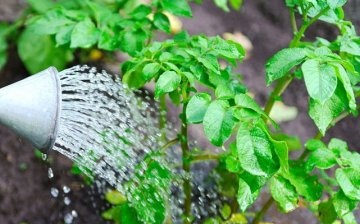
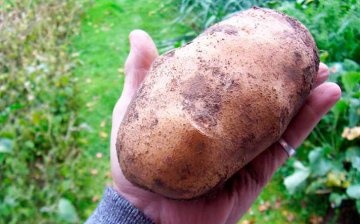
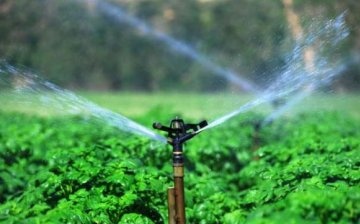
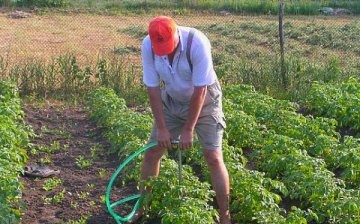
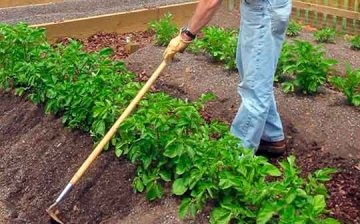





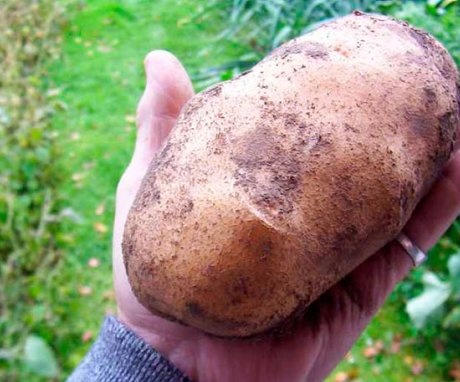
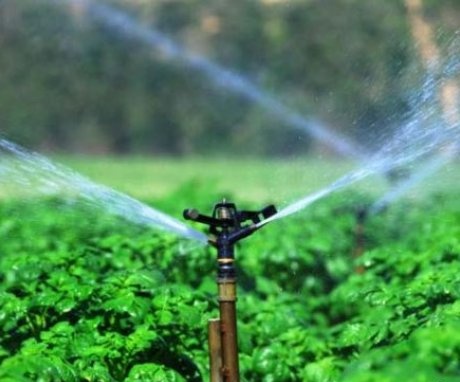
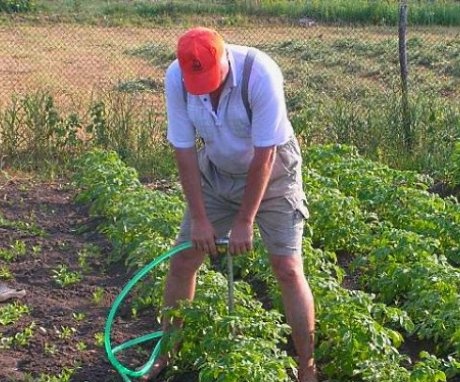
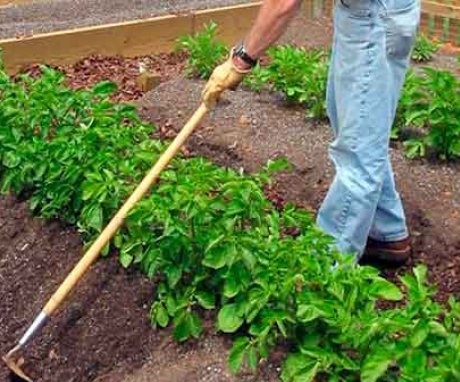
We always water the potatoes with warm water along the grooves in the aisles, water it abundantly, but not often, only a few times per season. Before watering the potatoes, we also apply fertilizers.
In hot summer, we try not to spare water for watering potatoes, after hilling it is not too difficult to do this, just fill the aisles with water. Our water comes from a well, quite cool, but quickly heats up in air.